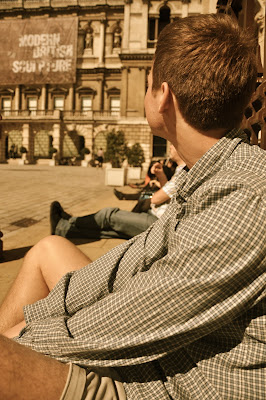
The inconspicuous art gallery bench
I have just finished my last ever university essay. A strange feeling; not sure it’s one I’ll miss though. The topic of my final exposition was an odd one (albeit slightly pretentious sounding) on the link between metaphor and art. Academic jargon and copious synonyms of ‘subsequently’ and ‘furthermore’ aside, it was about the figurative BS that pervades the art world. Don’t mistake me, I am a big fan of art and was mocked repeatedly whilst inter- railing for wanting to visit most galleries on the continent. I am also forever jealous of my school friends who went on to do fine art and fashion courses. Wistfully I ponder how fun making a portfolio of ideas and photos seems when trawling through Paradise Lost for the umpteenth time…Anyway I focussed my search for vom-inducing art criticism on the recent Miró ‘Ladder of Escape exhibition at the Tate, Modern.
What a disappointment that was. After paying an extortionate amount for ‘student’ entry (don’t get me started on that…a mere £1.50 off, a separate rant) I felt like an emotionless robot following hordes of punters around the samey labyrinthine rooms. I would stop, stand and stare and try to feel something about what was essentially was uninspiring squiggles and blobs of primary colour. I'm not adverse to abstract art, they were just boring and hardly differed from room to room. I almost felt sorry for the canvases, how many critical eyes were looking them up and down and spouting, ever so loudly trite ‘listen -to-me aren't I clever’ comments. I got to business on my essay research and read every adjoining placard about how each work was speaking and shouting about ‘the flowers of rebellion’. Surprisingly though, apart from the Tate trying to create the caricature of Miró the crazed Spanish rebel (who really wasn’t any Ché figure- he enjoyed copious siestas and property in Mallorca) there wasn’t that much I could point my finger at and say ‘there it is, classic, elitist art crap’. Instead I just got annoyed at the exploitation of his average prints on t-shirts, mouse mats and pens in the adjoining gift shop.
I inadvertently found my ultimate example of annoyingly figurative art speak at the Royal Academy’s Modern British Sculpture exhibition. I was busy observing one of Epstein’s enormous examples of male appendage when I spotted a standard looking bench on the far side of the room. I headed over and hesitated as I noted it had it’s own attached placard; briefly asking myself whether it was indeed a sculpture in itself. I had found it, a perfect case in point of ridiculous prose. It read ‘here a bench has been placed to offer temporary repose to a wilting public’. Was any of that necessary, it was a plain, brown, boxy bench? Who decided to write and place and hang such an unnecessary sentence? Apart from, possibly aristocratic older echelons of society, who seeks ‘repose’ these days? Or describes themselves as ‘wilting’? It made me resent sitting on the thing. Unfortunately, said essay couldn’t revolve around my disgust at the elitist and outdated approach of Britain’s leading art institutions but I think my general weariness at the bench incident pervaded it.
























